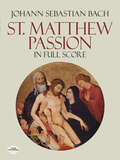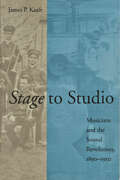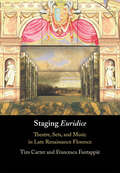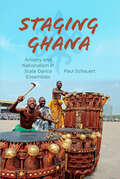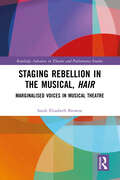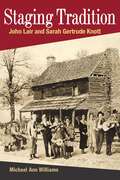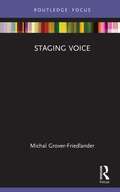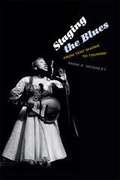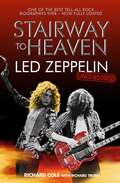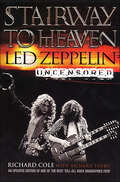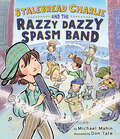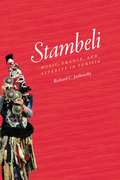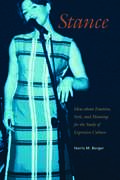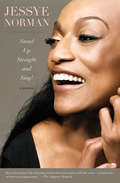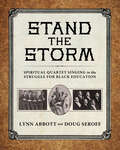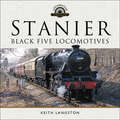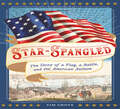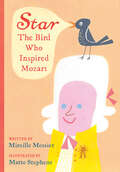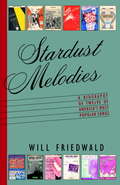- Table View
- List View
St. Matthew Passion: In Full Score
by Johann Sebastian BachOne of the most performed and recorded of Bach's major works, the St. Matthew Passion has been a focal point of concert seasons and festivals around the world for over 150 years. First performed in the late 1720s, it is a drama of epic grandeur, long considered the noblest, most inspired musical treatment of the story of the crucifixion of Christ. Bach set the text, based on two chapters from the Gospel of St. Matthew, using a large ensemble of two choruses, soloists, and two orchestras. The full score is reprinted here from the fine edition prepared by the Bach-Gesellschaft.Although the St. Matthew Passion is often held to be the apotheosis of Lutheran church music, this magnificent oratorio reaches out to its audience in the language, form, and spirit of opera. Richly dramatic and theatrical, following the general form of Baroque opera, it unfolds its deeply moving story in recitatives, ariosos, arias, chorales, and mighty choral movements. This finely produced score offers music lovers the opportunity -- at a price far lower than comparable editions -- to follow performances score in hand, and to gain a more intimate knowledge of the rich musical textures of this great masterwork.
Stage to Studio: Musicians and the Sound Revolution, 1890-1950 (Studies in Industry and Society #9)
by James P. KraftAward for Best Research in the Field of Record Labels or Manufacturers from the Association for Recorded Sound CollectionsWinner of the Kenneth W. Baldridge Prize from the Phi Alpha Theta Honor Society, Hawaii Region Between the late nineteenth and mid-twentieth century, technology transformed the entertainment industry as much as it did such heavy industries as coal and steel. Among those most directly affected were musicians, who had to adapt to successive inventions and refinements in audio technology—from wax cylinders and gramophones to radio and sound films. In this groundbreaking study, James P. Kraft explores the intersection of sound technology, corporate power, and artistic labor during this disruptive period.Kraft begins in the late nineteenth century's "golden age" of musicians, when demand for skilled instrumentalists often exceeded supply, analyzing the conflicts in concert halls, nightclubs, recording studios, radio stations, and Hollywood studios as musicians began to compete not only against their local counterparts but also against highly skilled workers in national "entertainment factories." Kraft offers an illuminating case study in the impact of technology on industry and society—and a provocative chapter in the cultural history of America.
Staging 'Euridice': Theatre, Sets, and Music in Late Renaissance Florence
by Tim Carter Francesca FantappièEuridice was one of several music-theatrical works commissioned to celebrate the wedding of Maria de' Medici and King Henri IV of France in Florence in October 1600. As the first 'opera' to survive complete, it has been viewed as a landmark work, but its libretto by Ottavio Rinuccini and music by Jacopo Peri and Giulio Caccini have tended to be studied in the abstract rather than as something to be performed in a specific time and place. Staging “Euridice” explores how newly-discovered documents can be used to precisely reconstruct every aspect of its original stage and sets in the room for which it was intended in the Palazzo Pitti. By also taking into account what the singers and instrumentalists did, what the audience saw and heard, and how things changed from creation through rehearsals to performance, this book brings new aspects of Euridice to light in startling ways.
Staging Ghana: Artistry And Nationalism In State Dance Ensembles (Ethnomusicology Multimedia)
by Paul SchauertThe Ghana Dance Ensemble takes Ghana's national culture and interprets it in performance using authentic dance forms adapted for local or foreign audiences. Often, says Paul Schauert, the aims of the ensemble and the aims of the individual performers work in opposition. Schauert discusses the history of the dance troupe and its role in Ghana's post-independence nation-building strategy and illustrates how the nation's culture makes its way onto the stage. He argues that as dancers negotiate the terrain of what is or is not authentic, they also find ways to express their personal aspirations, discovering, within the framework of nationalism or collective identity, that there is considerable room to reform national ideals through individual virtuosity.
Staging Rebellion in the Musical, Hair: Marginalised Voices in Musical Theatre (Routledge Advances in Theatre & Performance Studies)
by Sarah Elisabeth BrowneThis volume provides a comprehensive survey of the musical Hair and will offer critical analysis which focuses on giving voice to those who are historically considered to be on the margins of musical theatre history. Sarah Browne interrogates key scenes from the musical which will seek to identify the relationship between performance and the cultural moment. Whilst it is widely acknowledged that Hair is a product of the sixties counter-culture, this study will place the analysis in its socio-historical context to specifically reveal American values towards race, gender, and adolescence. In arguing that Hair is a rebellion against the established normative values of both American society and the art form of the musical itself, this book will suggest ways in which Hair can be considered utopian: not only as a utopian ‘text’ but in the practices and values it embodies, and the emotions it generates in its audiences. This book will be of great interest to scholars and students of music, musical theatre, popular music, American studies, film studies, gender studies, or African American studies.
Staging Tradition: John Lair and Sarah Gertrude Knott (Music in American Life)
by Michael Ann WilliamsBased on extensive archival research and oral history, Staging Tradition traces the parallel careers of the creators of the Renfro Valley Barn Dance and the National Folk Festival. Through their devotion to the staging of traditional culture, including folk, country, and bluegrass music, John Lair (1894-1985) and Sarah Gertrude Knott (1895-1984) became two of the mid-twentieth century's most notable producers. Lair and Knott's discovery of new developments in theater and entertainment during the 1920s led the pair to careers that kept each of them center stage. Inspired by programs such as WLS's Barn Dance and the success of early folk events, Lair promoted Kentucky musicians. Knott staged her own radically inclusive festival, which included Native and African American traditions and continues today as the National Folk Festival. Michael Ann Williams shows how Lair and Knott fed the public's fascination with the "art of the common man" and were in turn buffeted by cultural forces that developed around and beyond them.
Staging Voice (Routledge Voice Studies)
by Michal Grover-FriedlanderStaging Voice is a unique approach to the aesthetics of voice and its staging in performance. This study reflects on what it would mean to take opera’s decisive attribute—voice—as the foundation of its staged performance. The book thinks of staging through the medium of voice. It is a nuances exploration, which brings together scholarly and directorial interpretations, and engages in detail with less frequently performed works of major and influential 20th-century artists—Erik Satie, Bertolt Brecht and Kurt Weill—as well as exposes readers to an innovative experimental work of Evelyn Ficarra and Valerie Whittington. The study is intertwined throughout with the author’s staging of the works accessible online. This book will be of great interest to students and scholars in voice studies, opera, music theatre, musicology, directing, performance studies, practice-based research, theatre, visual art, stage design, and cultural studies.
Staging the Blues: From Tent Shows to Tourism
by Paige A. McginleySinging was just one element of blues performance in the early twentieth century. Ma Rainey, Bessie Smith, and other classic blues singers also tapped, joked, and flaunted extravagant costumes on tent show and black vaudeville stages. The press even described these women as "actresses" long before they achieved worldwide fame for their musical recordings. In Staging the Blues, Paige A. McGinley shows that even though folklorists, record producers, and festival promoters set the theatricality of early blues aside in favor of notions of authenticity, it remained creatively vibrant throughout the twentieth century. Highlighting performances by Rainey, Smith, Lead Belly, Sister Rosetta Tharpe, Sonny Terry, and Brownie McGhee in small Mississippi towns, Harlem theaters, and the industrial British North, this pioneering study foregrounds virtuoso blues artists who used the conventions of the theater, including dance, comedy, and costume, to stage black mobility, to challenge narratives of racial authenticity, and to fight for racial and economic justice.
Stairway To Heaven
by Richard ColeThe most powerful, popular and enduring rock band of all time, the excitement of Led Zeppelin's music was matched only by the fever pitch of their off-stage antics. In hotel rooms and stadiums, in a customized private Boeing 707 jet and country estates, tour manager Richard Cole saw it all - and here tells it all in this close-up, down-and-dirty, no-holds-barred account. This revised edition brings readers up to date on the lives and careers of the band members, whose wild excesses, bizarre lifestyles and ground-breaking music are now the stuff of legend.
Stairway To Heaven: Led Zeppelin Uncensored
by Richard Cole Richard TruboThis account of Led Zeppelin’s decadent life on the road by their longtime tour manager “dishes up the real dirt as only an insider’s report can” (Kirkus Reviews).No one knew Led Zeppelin like Richard Cole. The band’s tour manager for more than a decade, Cole was there when they burst onto the music scene, achieved cult status, cut platinum records, and transformed popular music. Second only to the Beatles in sales for years, Led Zeppelin was rock’s premier group. But unlike the boys from Liverpool, the excitement of this band’s music was matched by the fever pitch of their antics on and off the stage.In hotel rooms and stadiums, in a customized private Boeing 707 jet and country estates, Richard Cole saw it all—and tells it all in this close-up, down-and-dirty, no-holds-barred account that records the highs, the lows, and the occasional in-betweens. This revised edition includes updates on the band members’ lives and careers, which may be a little quieter now, but their songs remain the same.
Stalebread Charlie and the Razzy Dazzy Spasm Band
by Michael MahinBased on a true story, a vibrant, inspirational picture book about self-reliance and the power of creativity and music, in which a group of hungry homeless kids in 19th century New Orleans build their own musical instruments from discarded items and become a successful band. It's 1895, and ten-year-old Stalebread Charlie and his friend Warm Gravy roam the streets of New Orleans, homeless and hungry. Stalebread has heard folks say that music feeds the soul—and he wonders if it could also fill their bellies. Soon he and his friends are playing instruments made out of junk—a fiddle from a cigar box, a kazoo from a comb—until their hats are filled with coins, their bellies are filled with beignets, and their souls are filled with music. This inspiring make-lemonade-from-lemons tale includes author/illustrator notes about the real Stalebread and the research behind the book and a make-your-own-instrument activity.
Stambeli: Music, Trance, and Alterity in Tunisia (Chicago Studies in Ethnomusicology)
by Richard C. JankowskyIn Stambeli, Richard C. Jankowsky presents a vivid ethnographic account of the healing trance music created by the descendants of sub-Saharan slaves brought to Tunisia during the eighteenth and nineteenth centuries. Stambeli music calls upon an elaborate pantheon of sub-Saharan spirits and North African Muslim saints to heal humans through ritualized trance. Based on nearly two years of participation in the musical, ritual, and social worlds of stambeli musicians, Jankowsky’s study explores the way the music evokes the cross-cultural, migratory past of its originators and their encounters with the Arab-Islamic world in which they found themselves. Stambeli, Jankowsky avers, is thoroughly marked by a sense of otherness—the healing spirits, the founding musicians, and the instruments mostly come from outside Tunisia—which creates a unique space for profoundly meaningful interactions between sub-Saharan and North African people, beliefs, histories, and aesthetics. Part ethnography, part history of the complex relationship between Tunisia’s Arab and sub-Saharan populations, Stambeli will be welcomed by scholars and students of ethnomusicology, anthropology, African studies, and religion.
Stambeli: Music, Trance, and Alterity in Tunisia (Chicago Studies in Ethnomusicology)
by Richard C. JankowskyIn Stambeli, Richard C. Jankowsky presents a vivid ethnographic account of the healing trance music created by the descendants of sub-Saharan slaves brought to Tunisia during the eighteenth and nineteenth centuries. Stambeli music calls upon an elaborate pantheon of sub-Saharan spirits and North African Muslim saints to heal humans through ritualized trance. Based on nearly two years of participation in the musical, ritual, and social worlds of stambeli musicians, Jankowsky’s study explores the way the music evokes the cross-cultural, migratory past of its originators and their encounters with the Arab-Islamic world in which they found themselves. Stambeli, Jankowsky avers, is thoroughly marked by a sense of otherness—the healing spirits, the founding musicians, and the instruments mostly come from outside Tunisia—which creates a unique space for profoundly meaningful interactions between sub-Saharan and North African people, beliefs, histories, and aesthetics. Part ethnography, part history of the complex relationship between Tunisia’s Arab and sub-Saharan populations, Stambeli will be welcomed by scholars and students of ethnomusicology, anthropology, African studies, and religion.
Stambeli: Music, Trance, and Alterity in Tunisia (Chicago Studies in Ethnomusicology)
by Richard C. JankowskyIn Stambeli, Richard C. Jankowsky presents a vivid ethnographic account of the healing trance music created by the descendants of sub-Saharan slaves brought to Tunisia during the eighteenth and nineteenth centuries. Stambeli music calls upon an elaborate pantheon of sub-Saharan spirits and North African Muslim saints to heal humans through ritualized trance. Based on nearly two years of participation in the musical, ritual, and social worlds of stambeli musicians, Jankowsky’s study explores the way the music evokes the cross-cultural, migratory past of its originators and their encounters with the Arab-Islamic world in which they found themselves. Stambeli, Jankowsky avers, is thoroughly marked by a sense of otherness—the healing spirits, the founding musicians, and the instruments mostly come from outside Tunisia—which creates a unique space for profoundly meaningful interactions between sub-Saharan and North African people, beliefs, histories, and aesthetics. Part ethnography, part history of the complex relationship between Tunisia’s Arab and sub-Saharan populations, Stambeli will be welcomed by scholars and students of ethnomusicology, anthropology, African studies, and religion.
Stance: Ideas about Emotion, Style, and Meaning for the Study of Expressive Culture (Music Culture)
by Harris M. BergerWhy does music move us? How do the immediate situation and larger social contexts influence the meanings that people find in stories, rituals, or films? How do people engage with the images and sounds of a performance to make them come alive in sensuous, lived experience? Exploring these questions, Stance presents a major new theory of emotion, style, and meaning for the study of expressive culture. In clear language, the book reveals dimensions of lived experience that everyone is aware of but that scholars rarely account for.Though music is at the heart of the book, its arguments are illustrated with a wide range of clear examples--from the heavy metal concert to the recital hall, from festivals to dance, stand-up comedy, the movies, and beyond. Helping ethnographers get closer to the experiences of the people with whom they work, this book will be of immediate interest to anyone in ethnomusicology, folklore, popular music studies, anthropology, or performance studies.
Stand By Your Man: An Autobiography
by Tammy WynetteWynette, the queen of country western music, tells the inspiring life story of her ascent from rags to riches.
Stand Up Straight and Sing!: A Memoir
by Jessye NormanIn this uplifting memoir, the acclaimed singer reflects &“on life, the arts, and spirituality . . . Inspiring&” (Booklist). Jessye Norman is one of the world&’s most admired and beloved singers—and her life story is as moving and dramatic as the great operatic roles she has performed on stage. Born and raised in Augusta, Georgia, she studied the piano and sang the songs of her childhood, never dreaming that this passion for music might lead to her life&’s profession. Here she presents &“a rich portrait of a childhood firmly grounded by family, church and community,&” and recalls in rich detail the strong women who were her role models, from her ancestors to family friends, relatives, and teachers (The Wall Street Journal). She also discusses her relationship with the pioneering African American singer Marian Anderson—revealing the lifelong support she provided through her example of dignity and grace at all times. Norman also describes coming face-to-face with racism, both as a child living in the segregated South and as an adult out and about in the world. Filled with inspiration and wisdom, Stand Up Straight and Sing! is not just for lovers of music, but for everyone.
Stand the Storm: Spiritual Quartet Singing in the Struggle for Black Education (American Made Music Series)
by Lynn Abbott Doug SeroffBlack education in the South was the great social program of the post–Civil War era. Desperately strapped for operating capital, the first freedmen’s schools resorted to a bold fundraising experiment. Student troupes were sent to the North singing Negro spirituals, the sacred songs of slavery, in order to generate goodwill and entice financial support. The Fisk University Jubilee Singers set this strategy in motion in 1871; in the wake of their success, it was adopted by HBCUs throughout the Southland. Intrepid student singers introduced the outside world to the Negro spirituals, the “genuine jewels” they brought from their bondage, and “sang up” school buildings in the process. Negro spiritual singing was a revelation for the northern public; it was their initial exposure to an emergent, distinctly American kind of creative energy. Male quartets became the standard-bearers of this venerable Black music tradition. In Stand the Storm: Spiritual Quartet Singing in the Struggle for Black Education, award-winning authors Lynn Abbott and Doug Seroff dive into the history of three generations of fundraising quartets from seven representative schools: Fisk, Hampton, Tuskegee, Penn, Calhoun, Utica, and Piney Woods. They acknowledge the heroic founders of the schools and restore the names of forgotten singers to the historical record. They reevaluate the industrial education model that guided these schools. Finally, they plot the evolution of Negro spiritual singing after Emancipation by scrutinizing early published song collections and comparing them with songbooks and recordings from subsequent eras.
Standing in the Wings: The Beatles, Brian Epstein and Me
by Philip Norman Joe Flannery Mike BrockenJoe Flannery has been described as the ‘Secret Beatle’, and as the business associate and partner of Brian Epstein, he became an integral part of The Beatles’ management team during their rise to fame in the early 1960s.Standing in the Wings is Flannery’s account of this fascinating era, which included the controversial dismissal of Pete Best from the group (nothing to do with London, but matters back in Liverpool), Brian Epstein’s fragility, and the importance of the Star Club in Hamburg. This book is not simply a biography, as it also considers issues to do with sexuality in 1950s Liverpool, the vagaries of the music business at that time and the hazards of personal management in the ‘swinging sixties’. At its heart, Standing in the Wings provides an in-depth look at Flannery’s personal and professional relationship with Epstein and his close links with the Fab Four. Shortly before John Lennon’s murder in 1980, it was Flannery who was one of the last people in the UK to talk to the great man. Indeed, Flannery remains one of the few ‘Beatle people’ in Liverpool to have the respect of the surviving Beatles, and this is reflected in this timely and revealing book.
Stanier: Black Five Locomotives (Locomotive Portfolios)
by Keith LangstonIt is possible that in the history of British steam locomotives no class of engine was ever more universally popular than the Stanier 5MT 4-6-0 class, which were generally referred to as Black Fives. This informative book includes numerous images of the class at work, many of which are published for the first time.Introduced by the London Midland & Scottish Railway (LMS) in 1934 the building of the 842-strong class was shared between the locomotive works at Crewe, Horwich and Derby and also by the private builders Armstrong Whitworth Ltd. and Vulcan Foundry Ltd. With the exception of a pause in production during the war time years Black Five locomotives continued to be built until May 1951, when the last example was out-shopped from BR Horwich Works. Only four examples of the class were named, but a fifth locomotive was allocated a name which it reportedly never carried.They were often referred to as the finest mixed-traffic locomotives ever to run in Britain. William Arthur Stanier joined the LMS in 1932 having previously served the Great Western Railway (GWR) at Swindon Works, doubtless his LMS 2-cylinder tapered boiler Class 5 4-6-0 design reflected his Swindon experiences.This highly efficient and reliable general-purpose design (in several variants) could generally be seen at work over all of the former LMS network, from Thurso in the north of Scotland to Bournemouth (Somerset & Dorset Joint Railway) in the south of England. They became the ultimate go everywhere steam locomotives, working all manner of trains from slow goods to express passenger services.In 1967 just prior to the end of steam, British Railways remarkably listed 151 Stanier Black Fives as serviceable locomotives. A total of 18 Stanier Black Five locomotives survived into preservation, with the majority of those having been returned to steam.
Star Guitars: 101 Guitars That Rocked the World
by Dave HunterThese are the guitars so famous that their names are often household words: B. B. King’s Lucille, Eric Clapton’s Blackie, Stevie Ray Vaughan’s First Wife, Billy F Gibbons’ Pearly Gates, Neil Young’s Old Black, and many more. Here’s the first-ever illustrated history of the actual guitars of the stars that made the music. Other best-selling guitar histories look at the rank-and-file models, but this book is unique in profiling the actual “star guitars”—the million-dollar babies, such as the 1968 Stratocaster that Jimi Hendrix burned at Woodstock, which sold at Sotheby’s auction house in 1993 for $1,300,000. Amateurs buy guitars to emulate the stars—Clapton’s Strat, Slash’s Les Paul—and this book explains the stars’ modifications, thus showing how others can recreate those famous tones.
Star-Spangled Banner: The Unlikely Story of America's National Anthem
by Marc FerrisThe first comprehensive history of America’s controversial national anthem and how it evolved from an English barroom ballad into a patriotic hit.Nearly every American knows The Star-Spangled Banner, the national anthem of the United States of America. Yet many people dislike the song, contend that it glorifies militarism, and question its suitability as the musical embodiment of nationhood. Even professional vocalists have trouble singing the multi-octave melody and remembering the words. So why in 1931 did Congress designate it as the official national anthem, more than a century after Francis Scott Key put pen to paper?Filled with fascinating, little-known facts drawn from a variety of primary sources, Star-Spangled Banner provides the first narrative history of this controversial song, which turns 200 years old in 2014. Marc Ferris’s lively account, which traces the evolution of the song’s instant popularity as well as its use and abuse by Americans of different political stripes, also explains the changing rituals surrounding the song, including the practice of standing—with hats removed and hand held over the heart—during public performances.This entertaining book will appeal to patriots of all persuasions, along with sports fans, musicians, veterans, history buffs, and anyone who has ever struggled to hit the high notes in the land of the free and the home of the brave.
Star-Spangled: The Story of a Flag, a Battle, and the American Anthem
by Tim GroveThe inspiring story behind the national anthem and the American flag comes alive in this “page-turning narrative [with] generous archival illustrations” (Kirkus, starred review). “O say can you see” begins one of the most recognizable songs in the US. Originally a poem by Francis Scott Key, the national anthem tells the story of the American flag rising high above a fort after a night of intense battle during the War of 1812. But there is much more to the story than what is sung at ball games. What was this battle about? Whose bombs were bursting, and why were rockets glaring? Who sewed those broad stripes and bright stars? Why were free black soldiers fighting on both sides? Who was Francis Scott Key anyway, and how did he have such a close view? An illustrated history for young readers, Star-Spangled tells the whole story from the perspectives of different key figures—both American and British—of this obscure but important battle. The book includes an author’s note, a timeline, a glossary, endnotes, a bibliography, and an index.A Kirkus Best Book of 2020
Star: The Bird Who Inspired Mozart
by Mireille MessierA chance encounter with a starling inspires Wolfgang Amadeus Mozart in this picture book based on a true story.Star: The Bird Who Inspired Mozart is based on the true story of how Wolfgang Amadeus Mozart, one of the world's most remarkable musicians, was inspired by one of the world's most unremarkable birds: a starling. In this charming picture book, author Mireille Messier tells the story of a very special relationship and how it began: with a chance musical encounter. And Matte Stephens's playful art captures both the grandeur of 18th century Vienna and the budding unlikely friendship between a famous musician and a humble starling.
Stardust Melodies: A Biography of 12 of America's Most Popular Songs
by Will FriedwaldThis pop culture history takes 12 legendary songs and, with a staggering wealth of detail and unprecedented understanding, provides an extended history of each. The circumstances under which each was written and first performed are explained and their musical and lyric content are explored. Those who were responsible for making these songs famous and performers who have left their unique marks on them are also identified. Variations in style, classic and obscure versions, brilliantly original interpretations, and ghastly travesties in the performance lifetime of each song are discussed. Also included are revelations of facts, such as Herman Hupfeld, who wrote "As Time Goes By," had a much bigger hit with "When Yuba Plays the Rhumba on the Tuba"; Billy Strayhorn wrote about "a week in Paris" in "Lush Life" when he was a teenager and had never been to any city larger than Pittsburgh; and the first-ever public performance of "I Got Rhythm," sung by Ethel Merman, featured Benny Goodman, Gene Krupa, Jimmy Dorsey, and Glenn Miller.
